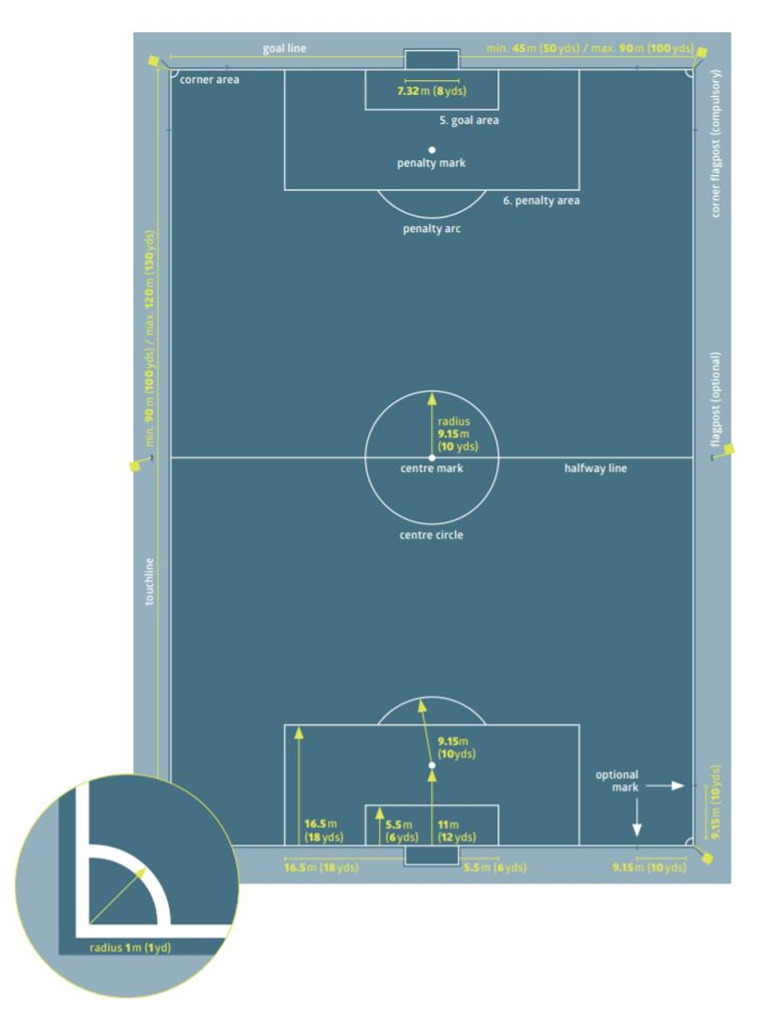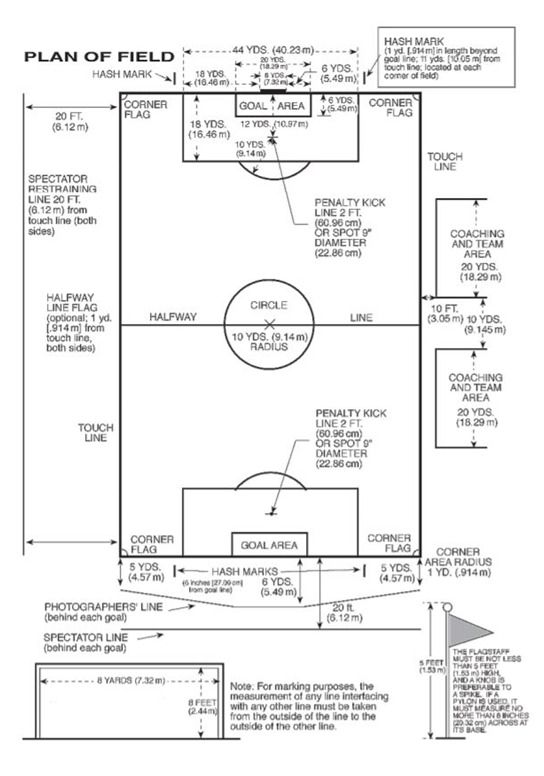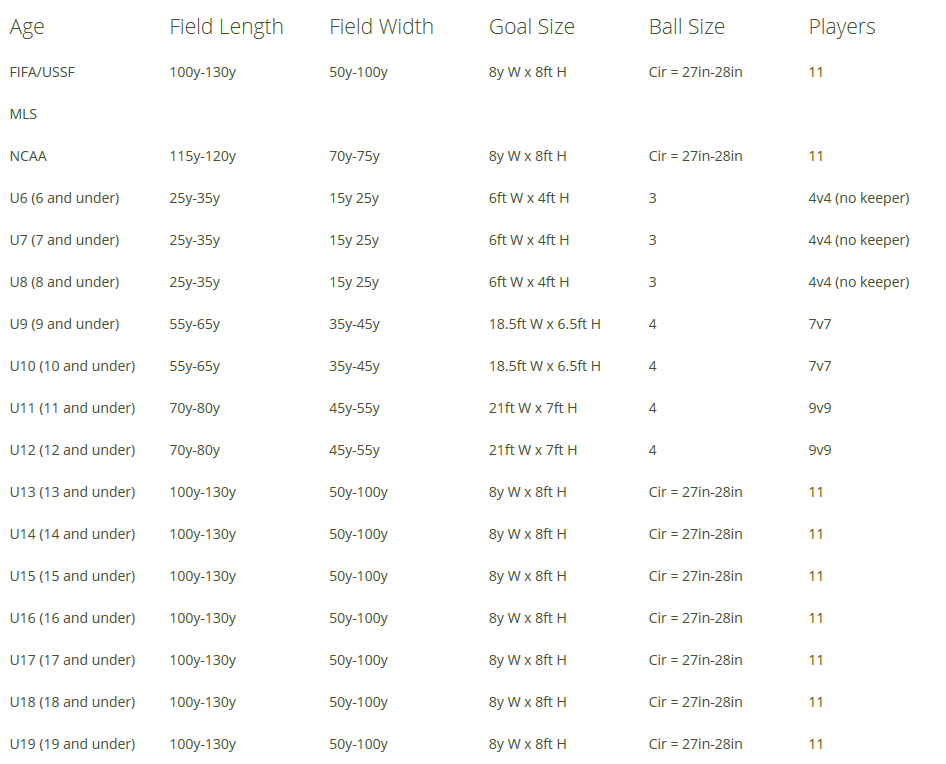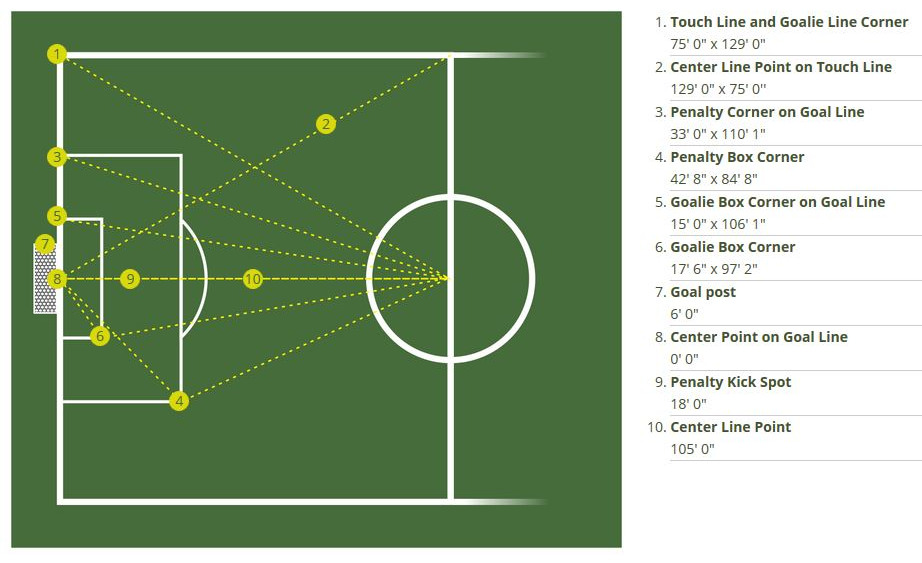Soccer Field Dimensions
The field of play shall be rectangular, the width of which shall not exceed the length. The width shall not be more than 80 yards (73.15M) nor less than 65 yards (59.44m) and the length shall not be more than 120 yards (109.72m) nor less than 110 yards (100.58m); however, fields of less than minimal dimensions may be used by prior written mutual consent of the competing institutions. The optimum size is 75 yards (68.58m) by 120 yards (109.73m).
FIFA & US Soccer
- Center Circle Radius = 10 Yards (9.15m)
- Touch Line = 100 Yards minimum 130 Yards Maximum (90m – 120m)
- Goal Line = 50 Yards minimum 100 yards maximum (45m – 90m)
FIFA International Match dimension Restrictions
- Center Circle Radius = 10 Yards (9.15m)
- Touch Line = 100 Yards minimum 120 Yards Maximum (100m – 110m)
- Goal Line = 70 Yards minimum 80 yards maximum (64m – 75m)
*The touchline must be longer then the goal line
NCAA
- Center Circle Radius = 10 Yards (9.15m)
- Touch Line = 115 Yards minimum 120 Yards Maximum (105.16m – 109.73m)
- Goal Line = 70 Yards minimum 75 yards maximum (64.01m – 68.58m)
*The touchline must be longer then the goal line
Goal Area Dimensions
FIFA & US Soccer
- A goal area is defined at each end of the field as follows: Two lines are drawn at right angles to the goal line, 6 yds (5.5 m) from the inside of each goal post. These lines extend into the field of play for a distance of 6 yds (5.5 m) and are joined by a line drawn parallel with the goal line. The area bounded by these lines and the goal line is the goal area.
NCAA
- A goal area is defined at each end of the field as follows: Two lines are drawn at right angles to the goal line, 6 yds (5.5 m) from the inside of each goal post. These lines extend into the field of play for a distance of 6 yds (5.5 m) and are joined by a line drawn parallel with the goal line. The area bounded by these lines and the goal line is the goal area.
Penalty Area
FIFA & US Soccer
- Two lines are drawn at right angles to the goal line, 18 yards (16.46m) from the inside of each goal post. The lines will extend into the field of play for a distance fo 18 yards (16.46m) and joined by line parallel with the goal line. At each end of the field, a two-foot (60.96cm) line or a nine-inch (22.86cm) spot will be placed at a point 12 yards (10.97m) from the midpoint of, and parallel to, to the goal line. The line will be draw with 12 inches on both sides of the center line. The spot will extend 4.5 inches on either side of the center line.
NCAA
- Two lines are drawn at right angles to the goal line, 18 yards (16.46m) from the inside of each goal post. The lines will extend into the field of play for a distance fo 18 yards (16.46m) and joined by line parallel with the goal line. At each end of the field, a two-foot (60.96cm) line or a nine-inch (22.86cm) spot will be placed at a point 12 yards (10.97m) from the midpoint of, and parallel to, to the goal line. The line will be draw with 12 inches on both sides of the center line. The spot will extend 4.5 inches on either side of the center line.
Corner Area
FIFA & Us Soccer
- The radius of the corner arc is 1 yard (1m) from the flag.
** A Corner Flag is a requirement and must be at least 5 feet in height (1.5m) and not have a point tip for safety purposes.
** There should also be flags located at least 1 yard outside of the field of play at either end of the halfway or midfield line.
NCAA
- The radius of the corner arc is 1 yard (1m) from the flag.
** A Corner Flag is a requirement and must be at least 5 feet in height (1.5m) and not have a point tip for safety purposes.
** There should also be flags located at least 1 yard outside of the field of play at either end of the halfway or midfield line.
Goals
FIFA & US Soccer
- Goals must be placed on the center of each goal line. They consist of two upright posts equidistant from the corner flagposts and joined at the top by a horizontal crossbar. The distance between the posts is 8 yds (7.32 m) and the distance from the lower edge of the crossbar to the ground is 8 ft (2.44 m). Both goalposts and the crossbar have the same width and depth, which do not exceed 5 ins (12 cm). The goal lines are the same width as that of the goalposts and the crossbar. Nets may be attached to the goals and the ground behind the goal, provided that they are properly supported and do not interfere with the goalkeeper. The goalposts and crossbars must be white.
NCAA
- Goals must be placed on the center of each goal line. They consist of two upright posts equidistant from the corner flagposts and joined at the top by a horizontal crossbar. The distance between the posts is 8 yds (7.32 m) and the distance from the lower edge of the crossbar to the ground is 8 ft (2.44 m). Both goalposts and the crossbar have the same width and depth, which do not exceed 5 ins (12 cm). The goal lines are the same width as that of the goalposts and the crossbar. Nets may be attached to the goals and the ground behind the goal, provided that they are properly supported and do not interfere with the goalkeeper. The goalposts and crossbars must be white.
Field Markings
FIFA & US Soccer
-The field of play is marked with lines. These lines belong to the areas of which they are boundaries. The two longer boundary lines are called touch lines. The two shorter lines are called goal lines. All lines are not less than 4 inches (10.16cm) in width nor more than 5 inches (12 cm) wide. The field of play is divided into two halves by a halfway line. The center mark is indicated at the midpoint of the halfway line. A circle with a radius of 10 yds (9.15m) is marked around it.
*On artificial surfaces other lines are permitted as long as they are a different color and clearly distinguishable form the lines of play.
NCAA
- The field of play is marked with lines. These lines belong to the areas of which they are boundaries. The two longer boundary lines are called touch lines. The two shorter lines are called goal lines. All lines are not less than 4 inches (10.16cm) in width nor more than 5 inches (12 cm) wide. The field of play is divided into two halves by a halfway line. The center mark is indicated at the midpoint of the halfway line. A circle with a radius of 10 yds (9.15m) is marked around it.
Diagrams
FIFA:

NCAA:

Disclaimer:
Below we have detailed out a quick reference guide for the various rules and regulations governing the marking of a soccer field in accord with various governing bodies. Please check with your organization to ensure that the guidelines and specifications used are in harmony with their own rules.

*The touchline must be longer then the goal line in all formats
Access a template for an organization youth soccer program and rules. Use this 6 page framework to enhance your own youth soccer program.
Field Images
Click the following links for an image of our soccer field dimensions:
Soccer Field Dimension, Soccer Field Layout, and Indoor Soccer Field Dimensions
Documents and Resources
FIFA Laws of the Game
FIFA Youth Soccer Info
NCAA Soccer Field Rules of Play
MLS Rules and Regulations
INTERNATIONAL
Official Soccer Field Dimensions
The field of play must be rectangular. The length of the touchline must be greater than the length of the goal line.
Length: minimum 100 yds (90 m), maximum 130 yds (120 m)
Width: minimum 50 yds (45 m), maximum 100 yds (90 m)
International Matches
Length: minimum 110 yds (100 m), maximum 120 yds (110 m)
Width: minimum 70 yds (64 m), maximum 80 yds (75 m)
Goals
Goals must be placed on the center of each goal line. They consist of two upright posts equidistant from the corner flagposts and joined at the top by a horizontal crossbar. The distance between the posts is 8 yds (7.32 m) and the distance from the lower edge of the crossbar to the ground is 8 ft (2.44 m). Both goalposts and the crossbar have the same width and depth, which do not exceed 5 ins (12 cm). The goal lines are the same width as that of the goalposts and the crossbar. Nets may be attached to the goals and the ground behind the goal, provided that they are properly supported and do not interfere with the goalkeeper. The goalposts and crossbars must be white.
Safety
Goals must be anchored securely to the ground. Portable goals may only be used if they satisfy this requirement.
Field Markings
The field of play is marked with lines. These lines belong to the areas of which they are boundaries. The two longer boundary lines are called touch lines. The two shorter lines are called goal lines. All lines are not less than 4 inches (10.16cm) in width nor more than 5 inches (12 cm) wide. The field of play is divided into two halves by a halfway line. The center mark is indicated at the midpoint of the halfway line. A circle with a radius of 10 yds (9.15m) is marked around it.
The Goal Area
A goal area is defined at each end of the field as follows: Two lines are drawn at right angles to the goal line, 6 yds (5.5 m) from the inside of each goal post. These lines extend into the field of play for a distance of 6 yds (5.5 m) and are joined by a line drawn parallel with the goal line. The area bounded by these lines and the goal line is the goal area.
Penalty area
Two lines are drawn at right angles to the goal line, 18 yards (16.46m) from the inside of each goal post. The lines will extend into the field of play for a distance fo 18 yards (16.46m) and joined by line parallel with the goal line.
At each end of the field, a two-foot (60.96cm) line or a nine-inch (22.86cm) spot will be placed at a point 12 yards (10.97m) from the midpoint of, and parallel to, to the goal line. The line will be draw with 12 inches on both sides of the center line. The spot will extend 4.5 inches on either side of the center line.
Corner Area, Hash Mark
From each corner, a quarter circle, having a radius of one yard (.914m) will be drawn. A hash mark one yard (.914m) situated six inches beyond the field of play and 11 yards (10.05m) from the touch line will be marked perpendicular to the goal line at each corner of the field.
Corner Flags
A flag on a post not less five feet (1.53m) high and having a non-pointed top will be placed at each corner. A similar flag pole may be placed opposite the halfway line on each side of the field of play at least one yard (.914m) outside the touch line.
The staff or post will be approximately 1.5 inches (3.81cm) thick and either round or square. The flag will be a bright color, about two feet (60.96cm) long by one foot (30.48) wide and secured to the staff or post. The base of the pylon or flag post will not be more than 8 inches (20.32cm) across.
Coaching and Team Areas
Team benches will be separated by a 10-yard neutral zone, and will be at least 10 feet (3.05m) from the touch line. The area will be marked parallel to the touch line and situated 10 feet from the touch line and extending 20 yards (18.29m) from the five-yard neutral zone measured from the halfway line in both directions.
Staking
When marking a soccer field (world football) for the first time and subsequent seasons how many points or intersections should you be staking ? Here's my quick calculations and why these are staking points for pulling a string line when marking a football field.
"Mandatory" staking points
4 - Four primary corners of the soccer field playing boundary, a "squared" field
8 - Goalie Box line both ends of the field (each corner of the box)
8 - Penalty Box line both ends of the field (each corner of the box)
2 - Midfield Line, at the Touch Line
2 - Penalty Kick Spot
3 - Center point of field, Center of each goal
27 - Subtotal
"Optional" staking points
2 - Halfway Line Flag
4 - Coach and Team Area, each corner, 10 foot off the touchline at 30 feet between each area
4 - Media safety zone, 12 foot off the sideline from four major corners
4 - Hash Mark, behind the
8 - Photographer Line, varies from 15' to 18' behind End Line
4 - Spectator Line, 20' from Touch and End Line
26 - Subtotal
Check out the different staking options using marking whiskers and associated stakes (nails and Raptor Stakes), Stake Alls integrated marking whisker with plastic stake, Tru Mark metal field line anchor with whisker plug.
Save time by using Tru Mark String Winders and the feature to allow for quick string recovery using a cordless drill.
Looking for temporary marking solution on synthetic turf field for that weekend tournament where the lines come off with water or foot/brush action, no special cleaning agent, the consider aerosol chalk ( different chalk colors, red, blue, yellow) or bulk liquid chalk.
Products/Resources
Marking whiskers paired with raptor stakes or penny nails can be used to mark the intersections on your field.
|
|
Use these whiskers with integrated stakes to mark the intersections on your field. |
|
Use this tool to lay out the lines on your field. Your cordless drill will wind the string back up in minutes! |
|
Use this set of pre-measured lines to mark your field in less time! |
Trumark Blog
Visit a new addition, Tru Mark's Trail Blazing Blog. Learn about field painting and turf tips, sports turf industry trends and future trends impacting our local community. Here is some information regarding soccer field operations.
Aerosol Chalk Versus Aerosol Paint
Synthetic Turf Trends--Minimizing Static Electricity
Movable Soccer Goal Safety Act Enacted into Law
Looking for Removable Field Paints for Use on a Sports Event
How Many Cans of Spray Paint to Line a Field?
Synthetic Sports Turf Fields -- Temporary Line Marking Solutions
Soccer Field Layout Tool
Access Our Soccer Field Layout Tool
Download our fast and accurate Soccer Field Layout Tool to help stripe your fields.
This simple layout tool takes the guess work out of creating a uniform soccer field no matter the dimension requirements.
Fast and Simple Tool for Generating Soccer Field Dimensions and Layout
Review the soccer field requirements to verify the field size dimensions based on participant ages.
 The TruMark Soccer Field Layout Tool is designed for soccer organizations and field striping personnel needing a simple yet accurate tool to help in laying out and striping their sports fields. No matter what you requirements you can generate symmetric dimensions for any age group or space restrictions.
The TruMark Soccer Field Layout Tool is designed for soccer organizations and field striping personnel needing a simple yet accurate tool to help in laying out and striping their sports fields. No matter what you requirements you can generate symmetric dimensions for any age group or space restrictions.
The soccer layout tool allows the user to plug in a value (in feet) into a cell below each listed soccer field dimension. The orientation of the layout tool is based on staking out the full length of field down the center line of pitch/field intersecting the goalie boxes. The actual field staking procedure requires the use of two measuring tapes. One tape is staked or held at the Center Line Point at the middle of the field and pulled to the associated intersection points. The other tape is staked or held at the Center Point on the Goal Line (between the goal posts). The layout tool calculates the intersections for the two tape measurements listed in feet and inches or just feet. The Soccer Layout Tool reflects the stake intersections for 1/4 of the soccer field.
The Soccer Field Layout Tool has gone through several updates as the result of users improving the overall layout and calculations.
What Our Customers Say:
|
"The field marking tool is fabulous. I can't believe we used to lay out our fields any other way. It easily cuts layout time down to a third of what it was. You can also do the job with only 3 people and there is no arguing like before."
- Bill in Massachusetts
|
|
"I appreciate the different methodology that is used. I have always marked a goal line first, then found the center & triangulated off that to where the center line meets the touch lines. I then triangulated off the center of the goal with various points on the goal line (goal box & penalty area) to find the PK & corners of the boxes not found on the goal line. I think your system is easier & perhaps more accurate."
- Bruce in Washington
|
|
"The template stops all arguments and saves a tremendous amount of time each season. I like the simplicity and the accuracy that it provides. I have not found a more logical way or a method that requires fewer steps to get that job done. One of the bonuses of this system is that if the permanent goal standards are not correctly set, the field will still come out with the best possible configuration than using any other method."
- Ken in Missouri
|
|
"I have to layout anywhere from 20 to 30 fields twice each year. The layouts that used to take a team of people hours to complete can now be done in less than 30-45 minutes by one person. I love it! AYSO Region 300, in the western suburbs of Chicago. We provide a soccer program for 2,500 - 3,000 players ranging in age from under 5 through high school.
- Kevin in Chicago
|
|
"The thought of no more stretching 300' tapes everywhere, Awesome! This tool is the best. My partner and I laid out and painted 3 fields in the same time it took a team of 3 to do 1 field."
- David in the State of Washington
|
|
"I lay out fields for an American Youth Soccer Organization league. For regular season this involves 19 or so fields and must be laid out in a two week period. This method really helps. I have used the 'sum of squares' method using 3 tapes, as well as surveying instruments. Also, used to have one or two others to help. With this method I can do the whole process by myself. I would say that with the former methods I could do a field: layout, mark and paint in about 90 minutes. With your method it is just under an hour! Layout of 1/2 of the field makes the other 1/2 much easier. I make a sheet for each age group and field size we need and use that as a guide. Also, I have the program on a portable computer for any changes. I also use a simple GPS Gamin Etrex to locate center of field and center of goal line."
- Doug in California
|